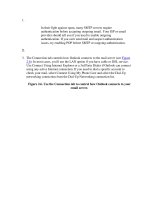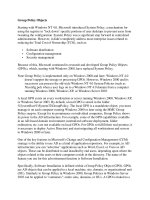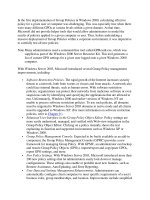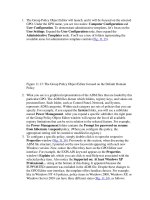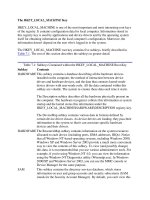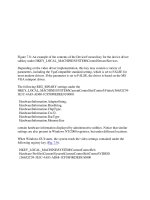Tài liệu The Spotlight Menu phần 1 doc
Bạn đang xem bản rút gọn của tài liệu. Xem và tải ngay bản đầy đủ của tài liệu tại đây (36.27 KB, 7 trang )
3.1. The Spotlight Menu
See the little magnifying-glass icon in your menu bar? That's the mouse-driven way to
open the Spotlight search box.
The other way is to press -Space bar. If you can memorize only one keystroke on
your Mac, that's the one to learn. It works both at the desktop and in other programs.
Tip: You can designate one of your F-keys (top row of the keyboard) to open Spotlight, if
you prefer. Choose System Preferences, click Spotlight, and use the "Spotlight
menu keyboard shortcut" pop-up menu.
In any case, the Spotlight text box appears just below your menu bar (Figure 3-1
).
Begin typing to identify what you want to find and open. For example, if you're trying to
find a file called Pokémon Fantasy League.doc, typing just pok or leag would probably
suffice. (Spotlight doesn't find text in the middles of words, though; it searches from the
beginnings of words.)
A menu immediately appears below the search box, listing everything Spotlight can find
containing what you've typed so far. (This is a live, interactive search; that is, Spotlight
modifies the menu of search results as you type.) The menu lists every file, folder,
program, email message, address book entry, calendar appointment, picture, movie, PDF
document, music file, Web bookmark, Microsoft Office (Word, PowerPoint, Excel,
Entourage) document, System Preferences panel, To Do item, chat transcript, Web site in
your History list, and even font that contains what you typed, regardless of its name or
folder location.
Figure 3-1. Left: Press -Space, or click the magnifying-glass icon, to make the
search bar appear.
Right: As you type, Spotlight builds the list of every match it can find, neatly
organized by
type: programs, documents, folders, images, PDF documents, and so on.
If you see the icon you were hoping to dig up, just click it to open it. Or use the arrow
keys to "walk down" the menu, and then press Return or Enter to open it.
If you click an application, it pops onto the screen. If you select a System Preferences
panel, System Preferences opens and presents that panel. If you choose an appointment,
the iCal program opens, already set to the appropriate day and time. Selecting an email
message opens that message in Mail or Entourage. And so on.
Spotlight is so fast, it eliminates a lot of the folders-in-folders business that's a side effect
of modern computing. Why burrow around in folders when you can open any file or
program with a couple of keystrokes?
3.1.1. Spotlight-Menu Tips
It should be no surprise that a feature as important as Spotlight comes loaded with
options, tips, and tricks. Here it is—the official, unexpurgated Spotlight Tip-O-Rama:
•
If the very first item—labeled Top Hit—is the icon you were looking for, just
press Return or Enter to open it. (That's a change in Leopard; adding the key
is no longer necessary.)
This is a huge deal, because it means that in most cases, you can perform the entire
operation without ever taking your hands off the keyboard.
To open Safari in a hurry, for example, press -Space bar (to open the Spotlight
bar), type safa, and hit Enter, all in rapid-fire sequence, without even looking.
Presto: Safari is before you.
(The only wrinkle here is that the Spotlight menu may still be building itself. If
you go too quickly, you may be surprised as another entry jumps into the top slot
just as you're about to hit Enter—and you wind up opening the wrong thing. Over
time, you develop a feel for when the Top Hit is reliably the one you want.)
GEM IN THE ROUGH
Sweet Spotlight Serendipity: Equations and Definitions
In Mac OS X 10.5, Spotlight has been given two quiet enhancements that turn it
into a different beast altogether.
First, it's a tiny pocket calculator, always at the ready. Click in the Search box,
type or paste 38*48.2-7+55, and marvel at the first result in the Spotlight menu:
1879.6. There's your answer—and you didn't even have to fire up the
Calculator.
(For shorter equations—only a few characters long—the first result in the
Spotlight menu shows the entire equation, like .15*234=35.1.)
And it's not just a four-function calculator, either. It works with square roots:
Type sqrt(25), and you'll get the answer 5. It also works with powers: Type
pow(6,6)—that is, 6 to the power of 6—and you'll get 46656.
You can even type pi to represent—you know, pi.
For a complete list of math functions in Spotlight, open Terminal (see Chapter
16), type man math, and press Enter.
Second, the Spotlight menu is now a full-blown English dictionary. Or, more
specifically, it's wired directly into Mac OS X's own dictionary, which sits in
your Applications folder.
So if you type, for example, schadenfreude in to the Spotlight box, you'll see, to
your amazement, the beginning of the actual definition right there in the menu.
Click it to open Dictionary and read the full-blown entry. (In this example, that
would be: "noun: pleasure derived by someone from another person's
misfortune.")
And what, exactly, is the Top Hit? Mac OS X chooses it based on its relevance
(the importance of your search term inside that item) and timeliness (when you
last opened it).
Tip: In Leopard more than ever, Spotlight makes a spectacular application
launcher. That's because, as you'll notice, Job #1 for Spotlight is to display the
names of matching programs in the results menu. Their names appear in the list
nearly instantly—long before Spotlight has built the rest of the menu of search
results.If some program on your hard drive doesn't have a Dock icon, for
example—or even if it does—there's no faster way to open it than to use Spotlight.
•
To jump to a search result's Finder icon instead of opening it, -click its name.
•
Spotlight's menu shows you only 20 of the most likely suspects, evenly divided
among the categories (Documents, Applications, and so on). The downside: To see
the complete list, you have to open the Spotlight window (Section 3.2
).
The upside: It's fairly easy to open something in this menu from the keyboard. Just
press -down arrow (or -up arrow) to jump from category to category.
Once you've highlighted the first result in a category, you can walk through the
remaining four by pressing the arrow key by itself. Then, once you've highlighted
what you want, press Return or Enter to open it.
In other words, you can get to anything in the Spotlight menu with only a few
keystrokes.
•
The Esc key (top-left corner of your keyboard) offers a two-stage "back out of
this" method. Tap it once to close the Spotlight menu and erase what you've typed,
so that you're all ready to type in something different. Tap Esc a second time to
close the Spotlight text box entirely, having given up on the whole idea of
searching.
(If you just want to cancel the whole thing in one step, press -Space bar again,
or -period, or -Esc.)
•
Think of Spotlight as your little black book. When you need to look up a number
in Address Book, don't bother opening Address Book; it's faster to use Spotlight.
You can type somebody's name or even part of someone's phone number.
•
Among a million other things, Spotlight tracks the keywords and descriptions
you've applied to your pictures in iPhoto. As a result, you can find, open, or insert
any iPhoto photo at any time, no matter what program you're using, just by using
the Spotlight box at the top of every Open File dialog box (Section 5.8.5
)! This is
a great way to insert a photo into an outgoing email message, a presentation, or a
Web page you're designing. iPhoto doesn't even have to be running.
•
Spotlight is also a quick way to adjust one of your Mac's preference settings.
Instead of opening up the System Preferences program, type the first few letters
of, say, volume or network or clock into Spotlight. The Spotlight menu lists the
appropriate System Preferences panel, so you can jump directly to it.
•
If you point to an item in the Spotlight menu without clicking, a little tooltip
balloon appears. It tells you the item's actual name—which is useful if Spotlight
listed something because of text that appears inside the file, not its name—and its
folder path (that is, where it is on your hard drive).
•
The Spotlight menu lists 20 found items. In the following pages, you'll learn about
how to see the rest of the stuff. But for now, note that you can eliminate some of
the categories that show up here (like PDF Documents or Bookmarks), and even
rearrange them, to permit more of the other kinds of things to enjoy those 20 seats
of honor. Details on Section 3.3
.
UP TO SPEED
What Spotlight Knows
The beauty of Spotlight is that it doesn't just find files whose names match what
you've typed. That would be so 2004!
No, Spotlight actually looks inside the files. It can actually read and search the
contents of text files, RTF and PDF documents, and documents from iWork,
Keynote, Pages, Photoshop, and Microsoft Office (Word, Excel, Entourage, and
PowerPoint).
As time goes on, software companies release bits of addon software—plugins—
that make their documents searchable by Spotlight too. Check in periodically at,
for example, www.apple.com/downloads/macosx/spotlight, to look for Spotlight
plug-ins relevant to the kind of work you do. For example, free Spotlight plug-
ins are available for OmniGraffle, OmniOutliner, TypeIt4Me, MacDraft,
REALBasic, Painter, Wolfram Notebook, and many others.
But that's only the beginning. Spotlight searches files not only for the text inside
them, but also for over 125 other bits of text—a staggering collection of
information tidbits including the names of the layers in a Photoshop document,
the tempo of an MP3 file, the shutter speed of a digital-camera photo, a movie's
copyright holder, a document's page size, and on and on.
Technically, this sort of secondary information is called metadata. It's usually
invisible, although a lot of it shows up in the Get Info dialog box described in
Chapter 2.
You might think that typing something into the Spotlight bar triggers a search.
But to be technically correct, Spotlight has already done its searching. In the
